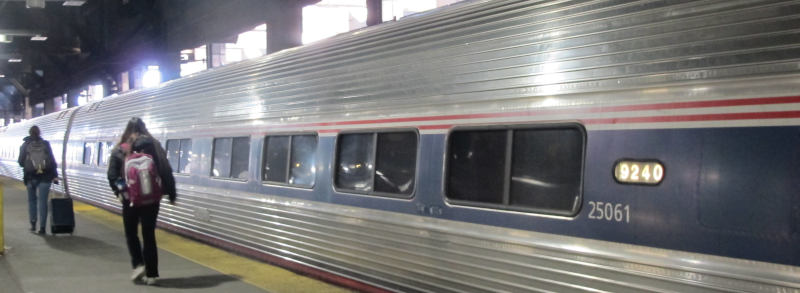
My carriage of the Lake Shore Limited train from Boston to Chicago.
To at least make good use of the all the pollution I caused with my recent transatlantic flight, I'm combining business in Cambridge, MA with business in Tucson, AZ. And to avoid further flight shame, I am doing the intra-US leg of the journey by train, that is, Amtrak. Now that I have managed to get into the train from Boston to Chicago (advertised when booking as Lake Shore Limited, though that name doesn't come up often on the train or in on-board announcements), I plan to write a bit of a travelogue as I go.
Departing in Anguish (13:40)
I'm seeing all this through the eyes of a regular if unhappy user of Deutsche Bahn (DB; cf. the Bahn tag on this blog if you can read German). Thus, I immediately felt at home when the train was delayed at Boston's South Station, except things were quite a bit more nerve-wrecking here.
You see, riding on the DB I'm used to knowing in advance on which track a train will depart. DB tells you that in the schedules they thankfully still post in the stations. Of course, they occasionally lie about which platform a delayed train will end up being redirected to, but still: It feels reassuring when one stands on a platform and can be reasonably sure that if and when the train departs (usually delayed, of course), you cannot miss it.
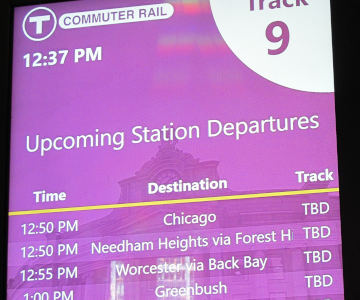
Not so over here. The displays say “track TBD“ until something like five minutes before departure. Well, five minutes before the scheduled departure of my train the display changed to “12:50 South Station Delayed“ – no word of Chicago any more. I'd certainly have panicked had I not closely watched the displays, even more so because had I missed that train, I'd probably have reached Tucson with a delay of two days given how sparse the connections are.
Someone must have noticed that something was awry on the display, because it changed again a short while later, to “12:50 Back Bay Delayed“. Back Bay, in case you've not been to Boston before, is a rather posh part of the city itself. Well… at least the departure time still matched the actual train. But then some indication of what order of magnitude of delay to expect be would have helped soothe my anxiety a bit.
After five minutes of anguish the confusing line on the display eventually showed a “Track 2” instead of “Delayed“, I rushed there, and at the remote end of the platform (the South Station is a railhead), a surprisingly short train – three or four coaches – was ready for boarding. Whoa.
Legroom Galore
I was somewhat concerned things might become tight because the ticket selling machine in Boston claimed the train was 80% full. Well – at least for now it's not; perhaps 50% of the seats are taken. Instead, there's a (by DB standards) surprising amount of legroom:
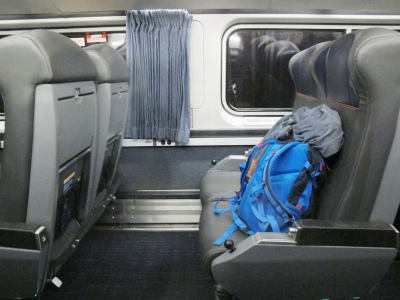
And now we're going roughly westwards, though a land of woods, lakes, and parking lots. We've just passed Worchester. And I halfway feel like I'm in Once Upon a Time in the West every time the engine hoots. It does this quite a lot here in central Massachusetts with its relatively tightly-knit road network.
The First Hours (16:30, 42.4N 73.1W)
We are still crossing Western Massachusetts, where you get to see, as I said, lots of trees and lakes:
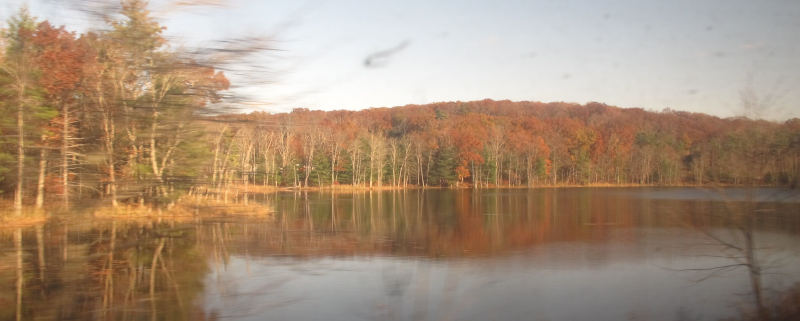
Meanwhile, before we entered Springfield, MA, a conductor walked through all the cars and called out the station. This felt oddly anachronistic, in particular because there were two additional announcement on the loudspeaker about only certain doors being available. But I still liked it. You see, it made me feel I could have asked a question, perhaps on a connecting train, if I had needed that. Granted, you couldn't do this sort of personalised service on a DB train with its (usually) much more frequent stops, and it certainly helps that this train has just three cars.
In Springfield, I also got a first taste of the disappearing railroad blues (as extolled in the 1972 song City of New Orleans):
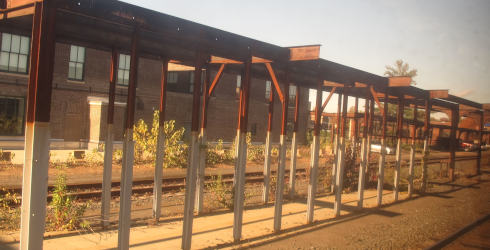
I'm rather sure this used to be a platform, and there once was a roof on top of the upper beams. Ah well – how many trains will there stop in Springfield? I think it's already outside of the area served by the MBTA communter rail and then… I'd expect that to be a very lonely station.
A Break at Albany, NY (18:30)
Now, that's a variation on train travel I've not yet seen anywhere else: The train has just stopped in Albany, NY – for a bit more than an hour. Almost everyone left the train. That's probably a rational behaviour since Amtrak subsequently cut power and even the toilets won't work any more. At least there are some emergency lights in the cars.
Nachtrag (2023-11-03)
Well – the power loss is a fairly compelling consequence of changing the engine, which this stop partly was about (see below). So, I should probably tone down the “cut” here. It's more that the power source was gone given HEP. Later on, however, my impression was that they're locking the toilets during stops at the station anyway. I'm not sure why they would do that, though, as in contrast to the Transsiberian (where they lock the Toilets like 5 minutes before entering a station), the Amfleet cars have closed wastewater systems (or so the Wikipedia claims).
The idea might be that people grab something to eat in the station hall; this mode of nourishment is popular on the Transsiberian, where they stop for about 30 minutes every 1000 kilometers or so to swap locomotives, and at least the locals get off and buy all kinds of stuff in little shops set up on the platforms. I frankly had not expected something remotely similar in the US.
On the other hand, the station hall in Albany has absolutely nothing in common with the dingy platforms of the stations along the Transsiberian. Actually, it is more reminiscent of an airline terminal than of what you would expect knowing DB stations:
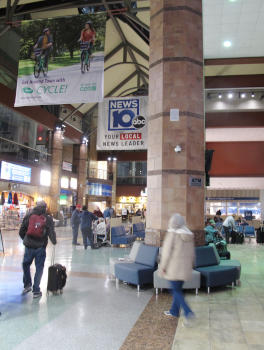
Only… there's just one cafe-and-convenience place in there, which didn't really appeal to me. That's the food option. Hm. I suppose if I wrote a user manual for Amtrak, I'd research reasonable food places that will feed you so that you are back in the train within one hour. On the other hand, I think the first car of our train is a dinining car; it's locked at the moment, but perhaps it will open later?
Right now there has been a bump at the train's end – who knows, perhaps they were just waiting for another part of the train to join us?
Back and Forth (19:05)
Hu? They said the train would leave at 19:04 (of course, 7:04 pm), and then suddenly the thing started moving at 18:58, which made the (few) people in the car seriously doubt whether they were on the right train. And even though I had been on that train since Boston and they had promised it would go to Chicago, I started to worry, too.
Then, after a few hundred meters, the train stopped and went back into the station. Um… exciting. There's clearly some serious shunting going on. That's something familiar for DB users: Mildly scary things happen and nobody tells you what's going on.
A minute later: another fairly violent bump. So – are we longer now? And shouldn't we be already be out of Albany for, what, four minutes now? Ah, in all fairness: someone from Amtrak just came into the (still dark) car and explained that something is „a little bit… delayed“. I feel almost at home.
Nachtrag (2023-11-03)
Over the next day I figured out what was going on: The Lake Shore Limited actually has two branches, the main one – including the sleeper cars – coming in from New York City. That's why the train was so short in Boston and until Albany, NY. There, the Boston branch was waiting for the New York part to come in. When it was there, the two parts were merged and then continued on together to Chicago. They probably even said as much in some announcement, but… well, another communality between DB and Amtrak is that the only announcements you can clearly understand are the ones you don't need.
The one thing I still have not worked out: why did the train have four (4!) engines in front of it when it arrived in Chicago?
Wifi and Emptyness (20:30)
Another thing feels as if I were in a DB train: Wifi is a pain. In the car I was in first, something immediately killed connections on the ethernet level, with log entries like:
kernel: wlan0: associated kernel: IPv6: ADDRCONF(NETDEV_CHANGE): wlan0: link becomes ready kernel: wlan0: deauthenticated from 5c:0e:8b:52:90:60 (Reason: 2=PREV_AUTH_NOT_VALID)
That wasn't just my box; I've had a look at matters using airodump, and the access point would just throw everyone out. Even iphones. Ha!
I then moved to another car, where the authentication (to an open network) worked, but of course there was a captive portal. Why, oh why? If one day some muckrake-wielding mob raids Harvard law school, it's annoyances like these that are to blame, in particular if they're as badly done as Amtrak's captive portal that, on all conservatively configured browsers forwards to https://www.ombord.info/hotspot/hotspot.cgi (Yes! CGI! I'd love it if it worked!), which on such browsers is a plain, black-on-white 403 forbidden.
On the other hand, once you are in using an absurdly permissive browser (I didn't bother to check what nastiness or botch-up there is in the portal code), network availability is surprisingly good given that the train traverses large areas that appear uninhabited. This afternoon, I spent quite a bit of time watching the leaves dance behind the train out of its rear window, where for a quarter of an hour you would see forests and hills without a trace of any settlement or even road (except the railroad, of course):
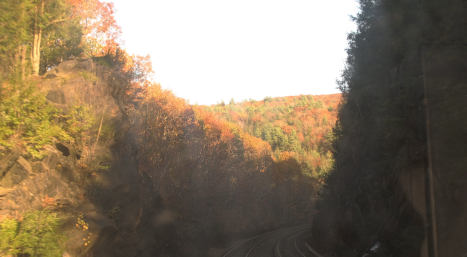
It was actually exciting when there was a road crossing the rail track.
I had expected to see a lot more agriculture out there in Western Massachusetts. It was a lot lonelier there than along the main trunk of the Transsiberian, and, judging from what lights are visible in the darkness we are now rolling through, than in upstate New York, too. Presumably that explains why people pay the outrageous prices of Boston real estate when they could presumably move into mansions like this:
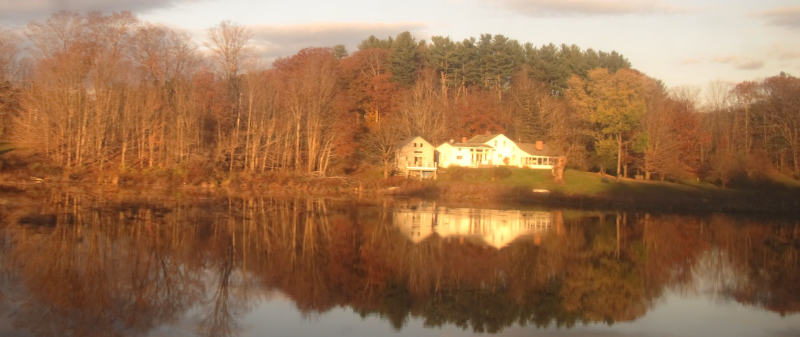
for a fraction of what they paid for their one-bedroom condo flat. I give you that no train will ever stop where I made that photo, not in a large radius. But our train still had an internet connection where that house stands.
Syracuse, Speed, and CO₂ (22:00)
So, indeed, what we bumped into in Albany would have been the sleeper cars. Here, in Syracuse, NY, we now stop twice, once for coach, once for sleepers. It seems the platform is pretty much on the short side, since for all I know at least the coach part of the train still is just three cars.
While that does not sound like impressive infrastructure, my Euro-chauvinist concerns about the state of the rails themselves were unfounded. At least here in the east they appear to be in reasonable shape. As far as I could see, the train never went slower than 80 km/h because of rail problems, and since we crossed the state border into New York, we are mostly in the 120 km/h range:
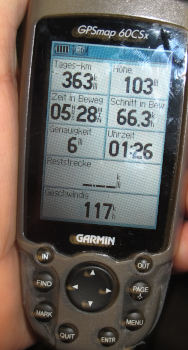
[I didn't fix the time zone, so it's still showing CET] Between Albany and Schenectady, the train even went 150 km/h, which frankly is all I'd ever ask of a train. After Schenectady, the 120 km/h felt a bit too bumpy for my taste, as I almost could not read on my computer screen when the box was sitting on the tray table. But still – I had imagined we'd go walking speed every few kilometres, more or less like currently the Red Line in Cambridge between Harvard and Central Square does. That is clearly not the case.
In retrospect, that is hardly surprising. It's probably something like 1600 km by rail between Boston and Chicago, which means that the train needs to do an average of 70 km/h to make it within the 22 hours it has. Even if it hadn't spent an hour just waiting in Albany that would mean it has to go 100-ish most of the time.
But the question of speed brings me to a difficult topic. I said above I'd be riding the train to avoid further flight shame. The truth is, of course, that I'm probably saving very little, if anything, in terms of CO₂ equivalents. The Wikipedia article on Amtrak says:
In 2005, Amtrak's carbon dioxide equivalent emissions were 0.411 lbs/mi (0.116 kg per km). For comparison, this is [...] about four times the average US motorcoach [...] It is, however, about two thirds of the raw CO2-equivalent emissions of a long-distance domestic flight.
So, just going to Chicago, I'll produce almost 200 kg CO₂ of emissions if I'm lucky (and I am probably not, because the train has emptied considerably by now). That is likely of the order of magnitude of the emissions of flying Boston-Chicago. For another reference, Mike Berners-Lee in How Bad Are Bananas estimates that flying 650 km from New York to Niagara Falls would be half a ton of CO₂ equivalent. Assuming that much of this will be take-off and landing, the Boston-Chicago flight would be roughly a ton.
The difference between a factor of five (200 kg rail vs. 1000 kg plane in this estimate) and the the factor of two thirds from the Wikipedia tells you that estimating the climate impact of just about anything is beastly hard to do properly. But it's patently clear that rail travel isn't all that clean either (least of all with a Diesel engine like the one pulling this train) and at least plays in the same stadium as flying.
Now, within comparable technology, clearly with increasing speed, emissions will rise strongly over-linearly. In that sense, slow trains are actually good. And I have to confess that if this were (only) about CO₂ footprints, I'd be sitting in a Greyhound bus now (yikes!).
Why Rail Beats Flying After All
But then this (apparent) futility is not the conclusive answer. Even if Wikipedia's dire estimate of train travel causing 2/3 of the emissions of a plane per unit distance were right – and I suspect for high-speed trains like the Acela it might very well be –, the big advantage of medium-speed train travel is: you just can't go so far because you generally don't have that much time.
The problem with planes is that it's easy and farily cheap to go 6000 km in a day – I just did the other day, going from Frankfurt to Boston in a mere eight hours. So, it's something many people do, some of them almost weekly. With medium-speed rail, travelling 6000 km is all you can do in a week. You simply won't do that very often.
And that, for me, is a strong argument for why rail generally steps much lighter on the Earth air travel: you cannot do as much of it. And not doing as much of it is the great secret of making anything more, <cough> sustainable.
With this, let my try reclining the seat. It's lights out in the coach class:
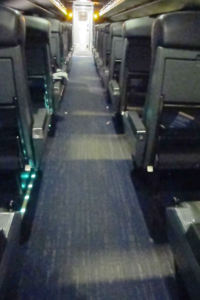
(Continued in Day 2).
Zitiert in: On the Acela from Boston to Washington Dossenheim to Malta on Rails Boston-Tucson on Amtrak: Day 4 Boston-Tucson on Amtrak: Day 3 Boston-Tucson on Amtrak: Day 2
![[RSS]](./theme/image/rss.png)